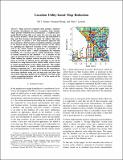| dc.contributor.author | Steiner, Ted J | |
| dc.contributor.author | Huang, Guoquan | |
| dc.contributor.author | Leonard, John J | |
| dc.date.accessioned | 2017-03-13T16:27:54Z | |
| dc.date.available | 2017-03-13T16:27:54Z | |
| dc.date.issued | 2015-07 | |
| dc.date.submitted | 2015-05 | |
| dc.identifier.isbn | 978-1-4799-6923-4 | |
| dc.identifier.isbn | 978-1-4799-6924-1 | |
| dc.identifier.isbn | 978-1-4799-6922-7 | |
| dc.identifier.other | INSPEC Accession Number: 15286382 | |
| dc.identifier.uri | http://hdl.handle.net/1721.1/107401 | |
| dc.description.abstract | Maps used for navigation often include a database of location descriptions for place recognition (loop closing), which permits bounded-error performance. A standard pose-graph SLAM system adds a new entry for every new pose into the location database, which grows linearly and unbounded in time and thus becomes unsustainable. To address this issue, in this paper we propose a new map-reduction approach that pre-constructs a fixed-size place-recognition database amenable to the limited storage and processing resources of the vehicle by exploiting the high-level structure of the environment as well as the vehicle motion. In particular, we introduce the concept of location utility - which encapsulates the visitation probability of a location and its spatial distribution relative to nearby locations in the database - as a measure of the value of potential loop-closure events to occur at that location. While finding the optimal reduced location database is NP-hard, we develop an efficient greedy algorithm to sort all the locations in a map based on their relative utility without access to sensor measurements or the vehicle trajectory. This enables pre-determination of a generic, limited-size place-recognition database containing the N best locations in the environment. To validate the proposed approach, we develop an open-source street-map simulator using real city-map data and show that an accurate map (pose-graph) can be attained even when using a place-recognition database with only 1% of the entries of the corresponding full database. | en_US |
| dc.description.sponsorship | Charles Stark Draper Laboratory (Fellowship) | en_US |
| dc.language.iso | en_US | |
| dc.publisher | Institute of Electrical and Electronics Engineers | en_US |
| dc.relation.isversionof | http://dx.doi.org/10.1109/ICRA.2015.7139223 | en_US |
| dc.rights | Creative Commons Attribution-Noncommercial-Share Alike | en_US |
| dc.rights.uri | http://creativecommons.org/licenses/by-nc-sa/4.0/ | en_US |
| dc.source | MIT Web Domain | en_US |
| dc.title | Location utility-based map reduction | en_US |
| dc.type | Article | en_US |
| dc.identifier.citation | Steiner, Ted J., Guoquan Huang, and John J. Leonard. “Location Utility-Based Map Reduction.” 2015 IEEE International Conference on Robotics and Automation (ICRA) (May 2015). | en_US |
| dc.contributor.department | Massachusetts Institute of Technology. Computer Science and Artificial Intelligence Laboratory | en_US |
| dc.contributor.department | Massachusetts Institute of Technology. Department of Aeronautics and Astronautics | en_US |
| dc.contributor.department | Massachusetts Institute of Technology. Department of Mechanical Engineering | en_US |
| dc.contributor.mitauthor | Steiner, Ted J | |
| dc.contributor.mitauthor | Huang, Guoquan | |
| dc.contributor.mitauthor | Leonard, John J | |
| dc.relation.journal | Proceeding of the 2015 IEEE International Conference on Robotics and Automation (ICRA) | en_US |
| dc.eprint.version | Author's final manuscript | en_US |
| dc.type.uri | http://purl.org/eprint/type/ConferencePaper | en_US |
| eprint.status | http://purl.org/eprint/status/NonPeerReviewed | en_US |
| dspace.orderedauthors | Steiner, Ted J.; Huang, Guoquan; Leonard, John J. | en_US |
| dspace.embargo.terms | N | en_US |
| dc.identifier.orcid | https://orcid.org/0000-0002-8863-6550 | |
| mit.license | OPEN_ACCESS_POLICY | en_US |
| mit.metadata.status | Complete | |
